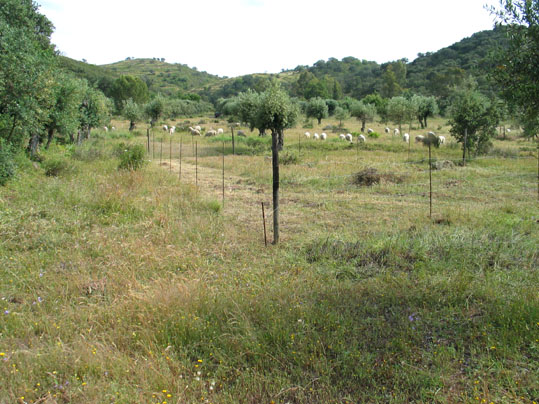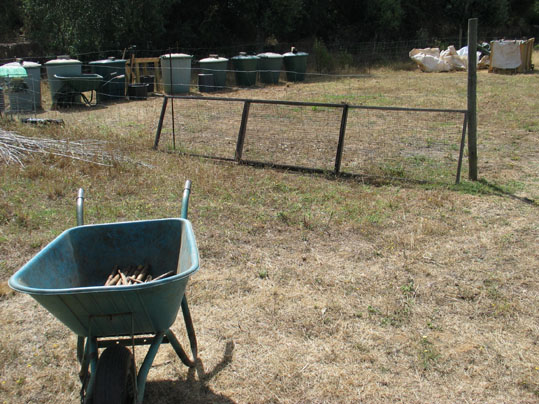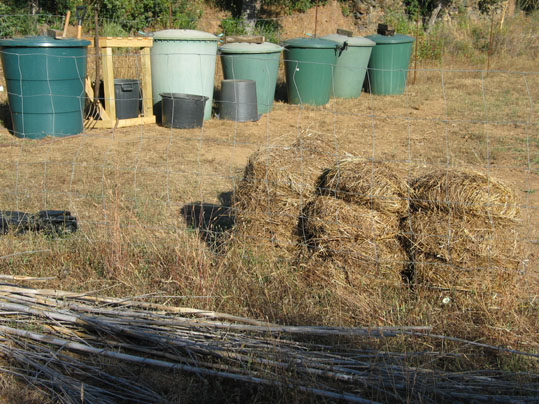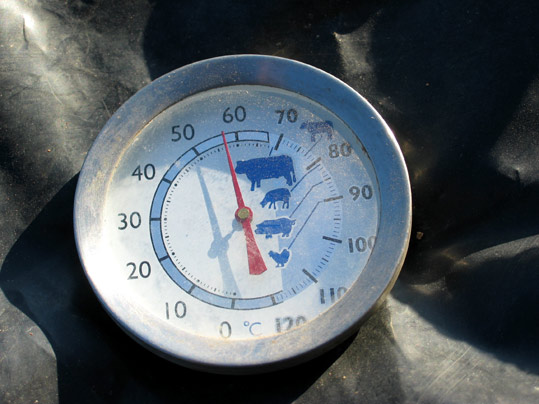With in memory the effects of the heat and drought of last summer, this is a relief... thunderclouds over a wet land:
 |
| May 2018. |
And this summer everything will be different
The composting
In the beginning of this summer, Hendrik made a discovery and was thus able to answer a long-running question: "Why in the big bag. does one part of the compost always dry out, and why is the other part always so nice and wet and does compost so nicely?"
The answer? All big bags are on a very small slope, with no more than 4 cm. difference. This difference ensures that the moisture in the hay slowly drops to the lowest point (in the course of its 3 to 4 months of composting). Because of this, the hay in the highest part composts badly, because without moisture it can not easily come to scalding.
"Well, now I'm sure!" Hendrik cried. "That I did not come up with this sooner! I really know for sure now, because the dry parts are all on the same side. It can not have anything to do with the wind, which I always thought, because the wind comes from the north. And the highest part is on the south, where there is the fence also, so no wind comes from there, the terrain is running down, and the humidity is running downwards, it has enough time to do so. The big bags must be absolutely horizontal. That is the only solution!"
And then we had a problem.
A Monte is simply a Monte. And a slope of no more than 4 cm. within a meter... how much is that anyhow? On a Monte we call this horizontally. Our only truly horizontal terrain is down by the river.
And then...
The fire hazard
The fires of the previous year are all etched into our memories. And that, especially since the government of Portugal has demanded far-reaching cleaning works around the houses in rural areas... accompanied by hefty fines, when they will not be met. The houses in the forest area in particular would be subject to a strict regime and the enforcement of the new law would be closely monitored. For example, it is the intention that up to 50 meters around each house all undergrowth should disappear. Likewise, all trees, with their crowns, closer than 5 meters from the house, should be cut.
In short; our landowner panicked more or less at the prospect of a fine of at least 10,000 euros. But we also hear other sounds... for it is peoples habit to produce other sounds... including sneering. And we also see other things... for example trees that grow out of houses and are still growing there.
Despite all this, our landowner took no risks...
It was a sad day. It rained a bit and it remained cloudy all week. When the sun started shining, it became very hot a few days... of course... and we missed the shade at the house... very bad.
Would this help with the risks associated with the commercial cultivation of eucalyptus for the paper industry? Would this help to prevent the fires that have been ignited by people? It's just a question...
The consequences for the hay storage
This is no longer allowed:
Too close to the house, here on top of the Monte. The hay must stay below. Well it may be clear that this also requires a new solution.
"I have to go down the Monte," Hendrik said.
"That's just the way it is."
Horizontal and fire safe
It is our lifelong habit to respond in terms of solutions... while maintaining this thing that never ever will dodge... the core of what we find is important... hard to put into words... the preservation of a self-esteem perhaps... the invariably ignoring of everything that seems beautiful but will prove to be unimportant in the long run, certainly. And if you have to throw everything upside down, why not make it into something nice and take advantage of the situation?
That we have to compost horizontally... okay, that is clear now. But this fire hazard... this came on suddenly. It did not exist yet, until the previous year, when it was so hot and dry. And now, while this summer is cooler than normal, this urgency also fades away. It is dead silent in the media and so on.
But now our homeowner is reassured and has no more sleepless nights. And we move on to the things of the day, find another spot in the shade to sit and think, and find a nice spot down by the river for composting. Only one problem arises... how is that with the water?
Usually the river is dry in the summer. Moreover, towing with buckets has no longer our preference. If we had been younger... well just think of something. A water pump? No, this does not work either. There is no electricity below. So... we bring the water down. With the cheapest means, in a country where one can buy everything in the field of irrigation... that must not to be too difficult.
 |
| Demarcated a piece of land where the sheep do not come. Mowed and leveled. |
 |
| All bins and barrels brought down.. The water hose is ready. |
 |
| Everything ready for use. |
A new invention by Hendrik, replacing the box where-in he always filled a big bag. His so-called 'filling bunker'. Quite a name for a conversion on wheels. A prototype, of course, because this idea has not yet fully crystallized and has to prove itself in practice.
It goes like this: Between the sides of the conversion there will be made a partition. The big bag goes into the square space. If it is filled with grafted hay, the partition will go out. The 'filling bunker' is driven a little further. Next to the filled big bag comes the new one. This is also filled... etc. Just as long as all the grafted hay (of the season) is finished and there is one long row, with several nicely juxtaposed big bags, which can then scald and compost for several months.
Will all of this succeed, according to plan? It is going to be an exciting time.
The real work
 |
| The mower mows. |
 |
| Treading packages in a barrel. |
 |
| Hendrik makes about 30 packages in the morning. |
 |
| The packages, ready for use... |
 |
| ...and the first immersion is already one day old. |
 |
| The stone. |
 |
| As clean as possible. A mess you can always make. |
 |
| See, that's what that table is for. Then you do not break your back. |
 |
| The mat. A subtle addition to the ease of use. |
 |
| On its way to the dripping barrel. |
 |
| And then everything in the dripping barrel. Dripping takes a day and a night. |
 |
Now on the way to the big bag in the 'filling bunker'.
Hendrik fills the big bag in one go. In addition to the immersion (grafting) barrel, he has 2 barrels to drip. After dripping the grafted hay goes to the 5 storage barrels, different in size and good for the storage of a total of 104 packs of grafted hay.
The summer temperature helps to start the heating.
What helps also is this spot that lies nicely in the shade of the hill, so the sun does not burn on the place all day. The process is not hindered by heat, the scalding does not go crazy or the big bags are not dried out. Which, on top of the Monte, was the reason to start composting in the winter. Furthermore, this mild summer also contributes to the success. We do not expect extreme heat this summer. |
 |
| And the temperature is already well on its way, so early in the morning. Will we reach the 60ºC? |
 |
And here we go for the second round.
All together one hour of work in the morning, to make packages, to immerse them and drip, and one hour in the evening, to mow. Mowing is done when the land is dry. And the trampling of packets you do when the land is wet with dew. |
 |
| Filling the grafting barrel... |
 |
...with this well-known ritual. Nice right?
And that at his age, with the 80 closer than the 75. |
 |
| And it surely helps! Because in another way you will not get this under water. |
 |
| Ready! Tomorrow we will see again. One day and a night grafting is enough. |
 |
| Finishing touch. Additional grafting fluid in the immersion barrel. Then all hay is under level. |
 |
| Cover on the grafting barrel... Goodbye, until tomorrow. |
 |
| The grafted hay goes into the dripping barrel. Also for a day and a night. |
 |
And hop... As if it's a sport. Everything helps to get all packages in the barrel.
Sometimes he does not have to jump in. But if it has to, then it has to. |
 |
| Covering moisture-tight. |
 |
Lid on the dripping barrel. Ready for today.
In the background we see the 'filling bunker' with an extra 'box' on it, which should make it possible to stack up high. Because during the composting the level drops considerably. The more there is in the big bag, the better. |
 |
| All the drained leachate from the dripping barrel and the wheelbarrow goes back to the 'source of all knowledge'... the tub with grafting fluid... composed of water, dissolved cow and sheep manure and leachate. With of course enough bacterial life to start our process every day very satisfactorily. |
How do we get our manure? Very easy. The cattle just comes to visit. The shepherd with his sheep mainly comes in the cooler period (autumn, winter and spring). And in the summer we sometimes have other visitors...
 |
| Further on in the hills, a large herd of cows grazes in a (for our terms) immeasurable terrain. They go wherever they want and in fact go their daily route from the grass to the river to drink and back again. But now as the river is already on its return and the water is slowly sinking, a small couple (family) sometimes wanders off. Through the almost dry riverbed they just walk around our fence, to check with us if there is something nice to eat. |
Seasonal work
 |
| There he is... Hendrik's first pride of the season. A well-filled and well-packed big bag. Horizontal and 'fire safe'. With his second companion under construction. Hendrik needs a ladder to fill the 'box'. |
Hendrik is very satisfied with this new situation. The work has become a lot easier. No more towing with packages of hay to the Monte. No more storage of hay, which must be covered and kept dry. No more waiting for the winter, starting with the composting. Very wise, by the way, now that the winters here also turn out to be cold, which hinders the scalding. (To be read in the
'Bad News' post of February this year.) We have access to a nice and spacious place to compost on flat terrain. And (not unimportant) a spot in the half shade, so the composting is not in the blazing sun all day long. In short, Hendrik is in a jubilant mood. This can hardly go wrong.
He now only mows his 600 m2 of fenced field, down by the river. This year we had to leave the maintenance of the rest of the terrain on the Monte, to the initiatives of the homeowner. (Next year, too? Here you never know.) In the morning, Hendrik tramples his packages (31 or 32 pieces) and goes straight on to composting. The packages are hardly stored. Within 8 days he has a big bag full with a total of 104 grafted packages of hay. We will soon be able to measure how much big bags this 600 m2 will produce.



Hendrik usually does not compost all packaged in one morning and then skips the mowing and trampling, because he still has enough in stock. And the work does not take a whole week. There are also days off... well... in fact it is free mornings and free evenings, because the days are free for other nice things to do in the period of mowing and composting. In addition, this is not a work that takes an entire year. We can not say how long all this will take now, but it is obvious that it is only a seasonal work. The composting itself, which takes place by the bacteria in the big bags, obviously takes months. But before the big bags can be opened Hendrik is just on hold. And that is entrusted to him.
Yahoo!! Everything is different!!
*
Stella.
 |
| After 8 days in the big bag ... 57ºC |











































Geen opmerkingen:
Een reactie posten